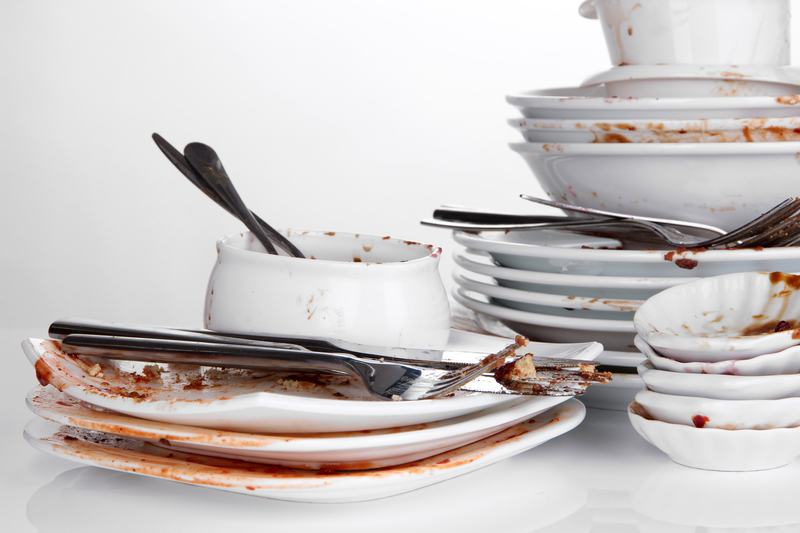Professional Car Cleaning: Secrets for a Flawless Vehicle
Posted on 18/08/2025
Professional Car Cleaning: Secrets for a Flawless Vehicle
Do you dream of your car gleaming like new all year round? Professional car cleaning isn't a mysterious art reserved only for high-end detailing shops--it's a science and skill anyone can learn with the right guidance. If you're serious about keeping your ride in impeccable condition, read on to explore the secrets behind a flawless vehicle, straight from car cleaning pros. This expert guide covers all the professional car cleaning methods, detailing techniques, and tools you need for showroom-worthy results.
Why Professional Car Cleaning Matters
A spotless car does more than look attractive--it preserves your investment, increases resale value, and extends the lifespan of your vehicle. Dirt, road salt, and embedded grime can eat away at your car's paint, upholstery, and undercarriage if left unaddressed. That's why mastering professional car cleaning secrets is essential for any car owner who wants more than just a quick wash.
- Enhanced Aesthetics: A professionally cleaned car turns heads everywhere it goes.
- Paint Protection: Removing stubborn contaminants prevents scratches and dullness.
- Higher Resale Value: Well-maintained cars fetch better prices on the used market.
- Longer Lifespan: Regular cleaning staves off corrosion and wear.

Preparing for Professional Car Cleaning
Gathering the Essential Tools and Products
Before you begin, assemble these critical supplies:
- Two-bucket wash system
- pH-balanced car shampoo
- High-quality microfiber towels
- Soft-bristled detailing brushes
- Clay bar or synthetic clay mitt
- Wheel cleaner and tire brushes
- Glass cleaner (ammonia-free)
- Paint-safe polish and car wax/sealant
- Upholstery and carpet cleaner
- Vacuum with crevice attachments
Tip: Invest in branded cleaning supplies designed specifically for automotive care. Household detergents can strip your car's protective coatings or damage sensitive surfaces.
Choosing the Right Environment
Professional car cleaning requires the right space. Work in a shaded area, ideally indoors, to prevent water spots and chemical evaporation caused by sunlight. Avoid cleaning on hot days or when your car's surface is extremely warm.
The Step-by-Step Professional Car Cleaning Process
1. Pre-Wash and Surface Rinse
Begin by rinsing your vehicle thoroughly to remove loose dirt and debris. Use a pressure washer or garden hose with a spray nozzle for optimal coverage. Pay close attention to the wheel wells and undercarriage, areas prone to heavy buildup.
2. Wheel and Tire Cleaning
Professional car cleaning always starts from the wheels--your car's dirtiest area. Spray on a dedicated wheel cleaner and let it sit briefly to break down brake dust. Agitate with a soft brush, then rinse thoroughly. Don't forget to scrub tires for a deep, even clean.
- Use separate brushes or mitts for wheels to avoid cross-contamination.
- Clean wheels one at a time to prevent chemical drying.
- Rinse all residue before moving on to the main body.
3. Contact Wash Using Two Bucket Method
The two-bucket method is a pro-approved technique to prevent swirl marks:
- Fill one bucket with a mixture of car shampoo and water; another with clean water.
- Dip your microfiber mitt into the soapy bucket, wash one section at a time.
- Rinse the mitt in the clean water, squeeze, and repeat.
Work from top to bottom--rooftop, windows, hood, doors, sides, and finally the bumpers and lower panels. This minimizes the risk of dragging coarse grit across the paintwork.
4. Decontamination: Clay Bar Treatment
Even after washing, your paintwork may feel rough to the touch. This means it's contaminated with stubborn particles. A clay bar or synthetic clay mitt draws out embedded contaminants for that glass-smooth finish:
- Lubricate the panel with clay lubricant or quick detailer spray.
- Glide the clay gently in straight lines; never use circular motions.
- Wipe residue with a clean microfiber towel.
Decontaminating your car every 3-6 months ensures that subsequent steps, like waxing or polishing, bond perfectly to the paint.
5. Drying with Microfiber Towels
Modern professional car cleaning shuns the outdated chamois. Instead, use soft, absorbent microfiber drying towels. Dab rather than drag across the surface to prevent fine scratches. For a flawless, streak-free result, use a dual-towel method--one for bulk drying, another for detailing nooks and crannies.
6. Polishing for Gloss and Scratch Removal
Once dry, inspect your paint under direct light. Minor blemishes, swirl marks, and oxidation can be removed with a fine polishing compound. Apply a small amount to an applicator pad, work in small sections, and buff away with a clean towel.
For maximum gloss, an automotive polishing machine (DA polisher) delivers professional grade shine, but always practice on a less-visible area first.
7. Protecting with Wax or Sealant
Applying a high-quality wax or paint sealant is the final defense in professional car cleaning. This step locks in your hard work, repels water, and deflects UV rays. Paste waxes offer deep shine, while modern synthetic sealants can last up to six months.
- Apply a thin, even coat with a foam or microfiber applicator.
- Allow the product to haze, then buff with a clean towel.
- Repeat every 3-6 months for ongoing protection.
Inside Secrets: Professional Car Interior Cleaning
A truly flawless vehicle isn't just spotless outside! The secret to comprehensive professional car cleaning is immaculate interiors.
Vacuuming Thoroughly
Start by removing floor mats and giving the entire cabin a deep vacuum, including under seats, between crevices, and seat upholstery. Use various attachments to reach into tight spots.
Cleaning Dashboards, Panels, and Vents
- Dilute an automotive interior cleaner and spray lightly onto a microfiber towel.
- Wipe down the dashboard, console, door panels, and steering wheel--avoid oversaturating electronics.
- Use a soft brush to agitate dust in air vents, then vacuum.
Carpet and Upholstery Deep Clean
For stubborn stains and spills, use a carpet extractor or foaming cleaner. Gently blot, don't scrub, to avoid pushing stains deeper. Allow all fabrics to dry thoroughly to prevent mildew.
Leather Seat Treatment
Clean leather with a dedicated leather cleaner, then apply conditioner to maintain suppleness and prevent cracking. Never use oils or household soaps, as these can cause damage and discoloration.
Streak-Free Glass and Mirrors
- Use an ammonia-free auto glass cleaner for inside and outside windows.
- Buff with a waffle weave microfiber towel for zero streaks.
- Don't forget rearview and side mirrors!
Advanced Professional Car Cleaning Techniques
Engine Bay Cleaning
Detailing pros know a flawless vehicle extends under the hood. Cover sensitive electronic components, then spray a degreaser on surfaces. Agitate with a brush and rinse gently. Finish by dressing hoses and plastics.
Headlight Restoration
Cloudy headlights are a dead giveaway of neglect. Restore clarity with a headlight polishing kit or a mild abrasive polish, then seal with UV protectant.
Odor Elimination
- Use an enzymatic cleaner or ozone generator for persistent smells.
- Replace cabin air filters regularly.
- Avoid masking odors with heavy fragrances; treat the source.
Secrets to Maintaining a Flawless Vehicle Between Cleans
Regular professional car cleaning brings the initial wow factor, but keeping it pristine requires ongoing habits. Here's how:
- Quickly Address Spills: Clean up food or drink accidents promptly to prevent permanent stains.
- Rinse Often: If your area uses road salt or you experience heavy pollen, rinse your car more frequently.
- Park in Shaded Spaces: This limits damage from UV rays, bird droppings, and tree sap.
- Use Seat Covers and Floor Mats: They absorb the brunt of daily wear, keeping upholstery fresh.
- Apply Spray Detailer: Quick detail sprays remove dust and add gloss between major washes.

Frequently Asked Questions about Professional Car Cleaning
How often should I professionally clean my car?
Most experts recommend a full professional car cleaning every 4-6 weeks, with lighter washes as needed in between. However, seasonal factors and local conditions may require more frequent attention.
Is hand washing better than automatic car washing?
Absolutely. Hand washing, especially with the two-bucket method and microfiber tools, is far gentler and more thorough than drive-through car washes, which can leave fine scratches or swirl marks.
What's the best way to avoid water spots?
Always dry your vehicle immediately after rinsing, and use filtered or softened water if possible. Microfiber towels and air blowers help prevent minerals from drying on the paint.
Can I use household cleaners on my car?
Never use household cleaning agents! These can strip protective coatings, fade plastics, or cause streaks and residue. Always opt for products meant for automotive surfaces.
Conclusion: Unleash Your Car's True Potential
Achieving a flawless vehicle isn't just about hard work--it's about using the right professional car cleaning secrets, products, and techniques. By adopting these methods, you'll not only protect your investment but also take pride in every drive. The time and care you put into your car reflects your standards and personality.
Remember: Professional results are within reach for everyone, provided you follow these proven tips. With consistency, attention to detail, and a little passion, your vehicle can outshine the rest--mile after mile.
Ready to start your own car cleaning journey? Gather your supplies, schedule your first session, and let your car's flawless finish do the talking!




